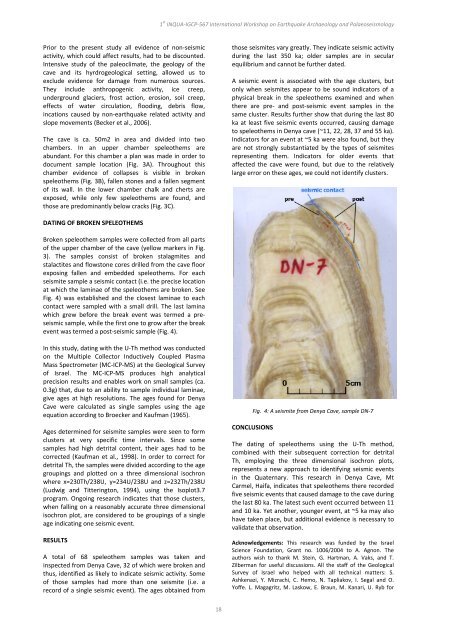Archaeoseismology and Palaeoseismology in the Alpine ... - Tierra
Archaeoseismology and Palaeoseismology in the Alpine ... - Tierra
Archaeoseismology and Palaeoseismology in the Alpine ... - Tierra
You also want an ePaper? Increase the reach of your titles
YUMPU automatically turns print PDFs into web optimized ePapers that Google loves.
Prior to <strong>the</strong> present study all evidence of non‐seismic<br />
activity, which could affect results, had to be discounted.<br />
Intensive study of <strong>the</strong> paleoclimate, <strong>the</strong> geology of <strong>the</strong><br />
cave <strong>and</strong> its hyrdrogeological sett<strong>in</strong>g, allowed us to<br />
exclude evidence for damage from numerous sources.<br />
They <strong>in</strong>clude anthropogenic activity, ice creep,<br />
underground glaciers, frost action, erosion, soil creep,<br />
effects of water circulation, flood<strong>in</strong>g, debris flow,<br />
<strong>in</strong>cations caused by non‐earthquake related activity <strong>and</strong><br />
slope movements (Becker et al., 2006).<br />
The cave is ca. 50m2 <strong>in</strong> area <strong>and</strong> divided <strong>in</strong>to two<br />
chambers. In an upper chamber speleo<strong>the</strong>ms are<br />
abundant. For this chamber a plan was made <strong>in</strong> order to<br />
document sample location (Fig. 3A). Throughout this<br />
chamber evidence of collapses is visible <strong>in</strong> broken<br />
speleo<strong>the</strong>ms (Fig. 3B), fallen stones <strong>and</strong> a fallen segment<br />
of its wall. In <strong>the</strong> lower chamber chalk <strong>and</strong> cherts are<br />
exposed, while only few speleo<strong>the</strong>ms are found, <strong>and</strong><br />
those are predom<strong>in</strong>antly below cracks (Fig. 3C).<br />
DATING OF BROKEN SPELEOTHEMS<br />
Broken speleo<strong>the</strong>m samples were collected from all parts<br />
of <strong>the</strong> upper chamber of <strong>the</strong> cave (yellow markers <strong>in</strong> Fig.<br />
3). The samples consist of broken stalagmites <strong>and</strong><br />
stalactites <strong>and</strong> flowstone cores drilled from <strong>the</strong> cave floor<br />
expos<strong>in</strong>g fallen <strong>and</strong> embedded speleo<strong>the</strong>ms. For each<br />
seismite sample a seismic contact (i.e. <strong>the</strong> precise location<br />
at which <strong>the</strong> lam<strong>in</strong>ae of <strong>the</strong> speleo<strong>the</strong>ms are broken. See<br />
Fig. 4) was established <strong>and</strong> <strong>the</strong> closest lam<strong>in</strong>ae to each<br />
contact were sampled with a small drill. The last lam<strong>in</strong>a<br />
which grew before <strong>the</strong> break event was termed a pre‐<br />
seismic sample, while <strong>the</strong> first one to grow after <strong>the</strong> break<br />
event was termed a post‐seismic sample (Fig. 4).<br />
In this study, dat<strong>in</strong>g with <strong>the</strong> U‐Th method was conducted<br />
on <strong>the</strong> Multiple Collector Inductively Coupled Plasma<br />
Mass Spectrometer (MC‐ICP‐MS) at <strong>the</strong> Geological Survey<br />
of Israel. The MC‐ICP‐MS produces high analytical<br />
precision results <strong>and</strong> enables work on small samples (ca.<br />
0.3g) that, due to an ability to sample <strong>in</strong>dividual lam<strong>in</strong>ae,<br />
give ages at high resolutions. The ages found for Denya<br />
Cave were calculated as s<strong>in</strong>gle samples us<strong>in</strong>g <strong>the</strong> age<br />
equation accord<strong>in</strong>g to Broecker <strong>and</strong> Kaufman (1965).<br />
Ages determ<strong>in</strong>ed for seismite samples were seen to form<br />
clusters at very specific time <strong>in</strong>tervals. S<strong>in</strong>ce some<br />
samples had high detrital content, <strong>the</strong>ir ages had to be<br />
corrected (Kaufman et al., 1998). In order to correct for<br />
detrital Th, <strong>the</strong> samples were divided accord<strong>in</strong>g to <strong>the</strong> age<br />
group<strong>in</strong>gs <strong>and</strong> plotted on a three dimensional isochron<br />
where x=230Th/238U, y=234U/238U <strong>and</strong> z=232Th/238U<br />
(Ludwig <strong>and</strong> Titter<strong>in</strong>gton, 1994), us<strong>in</strong>g <strong>the</strong> Isoplot3.7<br />
program. Ongo<strong>in</strong>g research <strong>in</strong>dicates that those clusters,<br />
when fall<strong>in</strong>g on a reasonably accurate three dimensional<br />
isochron plot, are considered to be group<strong>in</strong>gs of a s<strong>in</strong>gle<br />
age <strong>in</strong>dicat<strong>in</strong>g one seismic event.<br />
RESULTS<br />
A total of 68 speleo<strong>the</strong>m samples was taken <strong>and</strong><br />
<strong>in</strong>spected from Denya Cave, 32 of which were broken <strong>and</strong><br />
thus, identified as likely to <strong>in</strong>dicate seismic activity. Some<br />
of those samples had more than one seismite (i.e. a<br />
record of a s<strong>in</strong>gle seismic event). The ages obta<strong>in</strong>ed from<br />
1 st INQUA‐IGCP‐567 International Workshop on Earthquake Archaeology <strong>and</strong> <strong>Palaeoseismology</strong><br />
18<br />
those seismites vary greatly. They <strong>in</strong>dicate seismic activity<br />
dur<strong>in</strong>g <strong>the</strong> last 350 ka; older samples are <strong>in</strong> secular<br />
equilibrium <strong>and</strong> cannot be fur<strong>the</strong>r dated.<br />
A seismic event is associated with <strong>the</strong> age clusters, but<br />
only when seismites appear to be sound <strong>in</strong>dicators of a<br />
physical break <strong>in</strong> <strong>the</strong> speleo<strong>the</strong>ms exam<strong>in</strong>ed <strong>and</strong> when<br />
<strong>the</strong>re are pre‐ <strong>and</strong> post‐seismic event samples <strong>in</strong> <strong>the</strong><br />
same cluster. Results fur<strong>the</strong>r show that dur<strong>in</strong>g <strong>the</strong> last 80<br />
ka at least five seismic events occurred, caus<strong>in</strong>g damage<br />
to speleo<strong>the</strong>ms <strong>in</strong> Denya cave (~11, 22, 28, 37 <strong>and</strong> 55 ka).<br />
Indicators for an event at ~5 ka were also found, but <strong>the</strong>y<br />
are not strongly substantiated by <strong>the</strong> types of seismites<br />
represent<strong>in</strong>g <strong>the</strong>m. Indicators for older events that<br />
affected <strong>the</strong> cave were found, but due to <strong>the</strong> relatively<br />
large error on <strong>the</strong>se ages, we could not identify clusters.<br />
CONCLUSIONS<br />
Fig. 4: A seismite from Denya Cave, sample DN‐7<br />
The dat<strong>in</strong>g of speleo<strong>the</strong>ms us<strong>in</strong>g <strong>the</strong> U‐Th method,<br />
comb<strong>in</strong>ed with <strong>the</strong>ir subsequent correction for detrital<br />
Th, employ<strong>in</strong>g <strong>the</strong> three dimensional isochron plots,<br />
represents a new approach to identify<strong>in</strong>g seismic events<br />
<strong>in</strong> <strong>the</strong> Quaternary. This research <strong>in</strong> Denya Cave, Mt<br />
Carmel, Haifa, <strong>in</strong>dicates that speleo<strong>the</strong>ms <strong>the</strong>re recorded<br />
five seismic events that caused damage to <strong>the</strong> cave dur<strong>in</strong>g<br />
<strong>the</strong> last 80 ka. The latest such event occurred between 11<br />
<strong>and</strong> 10 ka. Yet ano<strong>the</strong>r, younger event, at ~5 ka may also<br />
have taken place, but additional evidence is necessary to<br />
validate that observation.<br />
Acknowledgements: This research was funded by <strong>the</strong> Israel<br />
Science Foundation, Grant no. 1006/2004 to A. Agnon. The<br />
authors wish to thank M. Ste<strong>in</strong>, G. Hartman, A. Vaks, <strong>and</strong> T.<br />
Zilberman for useful discussions. All <strong>the</strong> staff of <strong>the</strong> Geological<br />
Survey of Israel who helped with all technical matters: S.<br />
Ashkenazi, Y. Mizrachi, C. Hemo, N. Tapliakov, I. Segal <strong>and</strong> O.<br />
Yoffe. L. Magagritz, M. Laskow, E. Braun, M. Kanari, U. Ryb for



